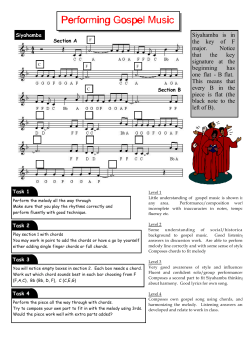
Document 129872
BASICS OF THEORY - MANDOLIN "Music Theory" is a phrase that can inspire fear and loathing among traditional musicians. Understandably so, as the presentation is often aimed at classical or jazz musicians, who speak very specific musical dialects. I'd like to present a few basic theory ideas with the traditional musician in mind. A truly detailed theory course is beyond the scope of this book; for those interested in more, Larry McCabe has assembled an excellent book Music Theory 101 available through Mel Bay Publications. Melodies consist of notes, usually belonging to a particular scale. A scale is simply a row of notes. The most basic form of a scale is the major scale, and in any key, the interval sequence is W W H W W W H. The half steps occur between notes three and four and seven and eight. The reason sharps and flats occur in scales is to keep the interval structure (distance between the notes) intact. Starting a major scale on any other note than C requires the use of some accidental (sharp or flat sign) to compensate. In traditional music forms such as bluegrass and American fiddle tunes, we are usually dealing with one tonal center, or key, for an extended duration of time, as opposed to jazz where key centers can shift every second. Melodies themselves reveal much about music theory: the notes that are used often spell out chordal possibilities. Let's look at the often used key of D: The notes of the D major scale are D E Ft G A B Cf. Every note of the scale is a potential chord tone. Chords are built in 3rds; in other words the most basic form of harmony is to take one note of the scale, skip the next note, and play the subsequent note: D Ft. Following the same process, we add the A note and we have notes one, three and five from the scale. This is a D major chord, also known as the I chord of the key. The same process gives us the following chords: ~XX~\O-&J^ I II III IV D major E minor Ftminor G major D Ft A EGB F#AC# GBD V A major VI B minor VII Ctdiminished ACtE B D Ft Ct E G The I, IV and V chords are major; the II, III and VI chords are minor, and the VII is diminished. The chord types are measured by the intervals between the root and 3rd of the chord, which are in turn determined by the interval structure of the scale itself, and where the half steps naturally occur. In traditional dance music, the chords that occur most frequently are the I, IV and V. The melodies of the tunes often imply chords, as the note choices often outline chord tones (the notes that make up a chord, for example, D Ft A, in any order, strongly imply a D chord sound). The keys used in this mandolin edition are C, G, D, A, and Em. The ten chords in this book, followed by the chord tones that define the chords: C (C E G) G (G B D) D (D Ft A) F(FAC) Dm(DFA) Am (A C E) A (A Ct E) Em (E G B) B7 (B Dt Ft A) E(EGtB) When an arpeggio (or arpeggiating) is mentioned, it is referring to a melodic structure that draws on chord tones. By knowing the notes of each chord, you'll find many more possibilities for melodic variation. 4
© Copyright 2025





















